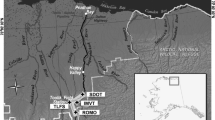Abstract
The effect of rise in spring air temperature on the breeding phenology and reproductive success of the Song Thrush in the Voronezh Nature Reserve have been studied over the periods of 1987 to 1990 and 2008 to 2012. The results show that relatively high air temperatures provide for earlier arrival of the birds from wintering grounds, earlier and more synchronous breeding of the majority of nesting pairs, and an increase in clutch size and proportion of pairs producing two broods per season. Predation pressure on bird nests decreases under such conditions, which markedly improves reproductive success. Climate warming is conducive to increasing breeding productivity of the Song Thrush population as a whole.
Similar content being viewed by others
References
Kuchin, A.P, Centennial and seasonal dynamics of Altai nature, Sib. Ekol. Zh, 1996, vol. 3, no. 2, pp. 179–181.
Sokolov, L.V., Tropp, E.A., Morozov, Yu.G., and Efremov, V.D, Effect of the temperature factor on the long-term fluctuations of the timing of migration, breeding, and dispersal of passerine birds, Dokl. Biol. Sci., 2001, vol. 379, pp. 362–365.
Amosov, P.N., Bragin, A.V., and Dobrynin, D.A, Effect of climate change on the bird fauna of northern European Russia, Izv. Ross. Akad. Nauk, Ser. Geogr., 2006, no. 5, pp. 30–35.
Vengerov, P.D, Effect of climate change on the timing of arrival and breeding of the Song Thrush (Turdus philomelos) and Chaffinch (Fringilla coelebs) in the Voronezh Nature Reserve, Usp. Sovrem. Biol., 2011, vol. 131, no. 4, pp. 416–424.
Vengerov, P.D., Specific features in the breeding timing of the Chaffinch (Fringilla coelebs) and Pied Flycatcher (Ficedula hypoleuca) under conditions of high spring temperatures, Nauch. Vedomosti Belgorod. Gos. Univ., Ser. Estestv. Nauki, 2014, vol. 17 (188), no. 28, pp. 76–81.
Forchhammer, M., Post, E., and Stenseth, N.Chr., Breeding phenology and climate, Nature, 1998, vol. 391, no. 6662, pp. 29–30.
Moss, S, Predictions of the effects of global climate change on Britain’s birds, Brit. Birds, 1998, vol. 91, no. 8, pp. 307–325.
Crick, H.Q.P. and Sparks, T.H, Climate change related to egg-laying trends, Nature, 1999, vol. 400, no. 6741, pp. 423–424.
Brommer, J.E, The range margins of northern birds shift polewards, Ann. Zool. Fenn., 2004, vol. 41, no. 2, pp. 391–397.
Sanz, J., Potti, J., Moreno, J., et al., Climate change and fitness components of a migratory bird breeding in the Mediterranean region, Global Change Biol., 2003, vol. 9, no. 3, pp. 461–472.
Lehikoinen, A., Byholm, P., Ranta, E., et al., Reproduction of the Common Buzzard at its northern range margin under climatic change, Oikos, 2009, vol. 118, no. 6, pp. 829–836.
Artemyev, A.V, The influence of climate change on the ecology of the Pied Flycatcher (Ficedula hypoleuca) in Southern Karelia, Russ. J. Ecol., 2013, vol. 44, no. 3, pp. 239–246.
Halupka, L., Dyrcz, A., and Borowiec, M., Climate change affects breeding of Reed Warblers Acrocephalus scirpaceus, J. Avian Biol., 2008, vol. 39, no. 1, pp. 95–100.
Vengerov, P.D., Sapel’nikova, I.I., Bazil’skaya, I.V., and Masalykin, A.I., Climatic changes and their direct and indirect effects observed in the Voronezh Nature Reserve, in Vliyanie izmenenii klimata na ekosistemy (Effects of Climate Change on Ecosystems), Moscow: Russkii Universitet, 2001, pp. 39–47.
Sapel’nikova, I.I., Bazil’skaya, I.V., and Gribkova, A.S, Some facts indicating the warming of spring temperatures in the Voronezh Nature Reserve, Tr. Voronezh. Gos. Zap., Voronezh, 2012, no. 26, pp. 7–16.
Payevsky, V.A., Demografiya ptits (Bird Demography), Tr. Zool. Inst. Akad. Nauk SSSR, vol. 125, Leningrad: Nauka, 1985.
Schnack, S, The breeding biology and nestling diet of the Blackbird Turdus merula L. and the Song Thrush Turdus philomelos C.L. Brehm in Vienna and in an adjacent wood, Acta Ornithol., 1991, vol. 26, no. 2, pp. 85–106.
Wesolowski, T. and Czapulak, A., Biologia rozrodu kosa (Turdus merula) i drozda spiewaka (Turdus philomelos) w Polsce–wstepna analiza kart gniazdowych, Not. Ornitol., 1986, vol. 27, nos. 1–2, pp. 31–60.
Lack, D., The Natural Regulation of Animal Numbers, Oxford: Clarendon, 1954. Translated under the title Chislennost’ zhivotnykh i ee regulyatsiya v prirode, Moscow: Izd. Inostrannoi Literatury, 1957.
Bolotnikov, A.M., Shurakov, A.I., and Shkarin, V.S, On the breeding ecology of thrushes in the Cisural region, Uch. Zap. Perm. Gos. Ped. Inst., 1973, no. 113, pp. 29–34.
Golovan’, V.I., Productivity and reproductive success of three thrush species (Turdus spp.) in the southwest of Pskov oblast, Russ. Ornitol. Zh., 2006, vol. 15, express issue no. 313, pp. 255–263.
Mal’chevskii, A.S. and Pukinskii, Yu.B., Ptitsy Leningradskoi oblasti i sopredel’nykh territorii: Istoriya, biologiya, okhrana (Birds of Leningrad Oblast and Bordering Territories: History, Biology, Protection), Leningrad: Leningr. Gos. Univ., 1983, vol. 2.
Sotnikov, V.N., Ptitsy Kirovskoi Oblasti i sopredel’nykh territorii (Birds of Kirov Oblast and Bordering Territories), vol. 2: Vorob’inoobraznye (Passeriformes), part 2, Kirov: OOO Triada-Plyus, 2008.
Khokhlova, T.Yu., Population adaptations to the conditions of northern taiga zone in closely related bird species with polycyclic breeding: The example of thrushes of the genus Turdus, Extended Abstract of Doctoral (Biol.) Dissertation, St. Petersburg, 2011.
Moskvitin, S.S. and Blinov, V.N., Relationships of the Hooded Crow and Fieldfare in the subtaiga zone of Western Siberia, in Ekologiya i biotsenoticheskie svyazi pereletnykh ptits Zapadnoi Sibiri (Ecology and Biocenotic Relationships of Migratory Birds in Western Siberia), Novosibirsk, 1981, pp. 127–137.
Zakharova, L.S. and Yakovleva, M.V, Seasonal variation in clutch size and reproductive success of the Fieldfare, Turdus pilaris, in the Kivach Nature Reserve, Karelia, Russ. Ornitol. Zh., 1999, vol. 8, no. 71, pp. 3–8.
Berezantseva, M.S., The feeding of Song Thrush (Turdus philomelos) nestlings in the Les na Vorskle oak forest, the forest–steppe zone, Russ. Ornitol. Zh., 1997, express issue no. 12, pp. 8–15.
Author information
Authors and Affiliations
Corresponding author
Additional information
Original Russian Text © P.D. Vengerov, 2017, published in Ekologiya, 2017, No. 2, pp. 134–140.
Rights and permissions
About this article
Cite this article
Vengerov, P.D. Effect of rise in spring air temperature on the arrival dates and reproductive success of the Song Thrush, Turdus philomelos (C.L. Brehm, 1831) in the forest–steppe of the Russian Plain. Russ J Ecol 48, 178–184 (2017). https://doi.org/10.1134/S1067413617020102
Received:
Published:
Issue Date:
DOI: https://doi.org/10.1134/S1067413617020102




